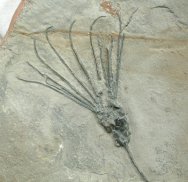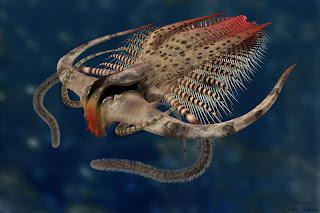[Recent Entries][Archive][Friends][User Info]
August 5th, 2011
| August 5th, 2011 | |
|---|---|
| 11:59 am [industrialterro] [Link] |
Dinomischus Dinomischus is a rare fossil animal from the Cambrian period. It reached 100 mm in height, was attached to the sea floor by a stalk, and looked loosely like a flower. The cup-shaped body at the top of the stalk probably fed by filtering the surrounding seawater, and may have created a current to facilitate this. Its mouth and anus sat next to one another. Dinomischus is not the only organism of its kind in the Cambrian; a similar, larger organism known as the "tulip animal" has also been recovered, but not yet described, from the Burgess shale. It has also been likened to Eldonia and Velumbrella, although unlike Dinomischus these medusoid organisms have tentacles.
Tags: Вымершие беспозвоночные, Кембрий |
| Time | Event |
| 12:07 pm [industrialterro] [Link] |
Эокриноидея Эокриноидеи (Eocrinoidea), класс вымерших беспозвоночных животных типа иглокожих. Жили в кембрии и ордовике. Амбулакральная система примитивная. Скелет эокриноидеи состоял из теки, брахиол, или ручек, и у большинства - из ножки, или стебля, служивших для прикрепления. Рот был на вершине теки, анальное отверстие - сбоку от него. Брахиолы улавливали частицы пищи, направлявшиеся по желобкам, переходящим на теку, ко рту. На границах табличек теки часто имелись поры - эписпиры, по-видимому, служившие для дыхания. Эокриноидеи были распространены почти всесветно в раннепалеозойских морях, но их остатки встречаются относительно редко. Известно около 30 родов эокриноидей с 50 видами, главным образом из отложений Европы и Северной Америки; в СССР - из кембрия Якутии и ордовика Ленинградской области и Эстонии.
Tags: Вымершие беспозвоночные, Кембрий |
| Time | Event |
| 12:27 pm [industrialterro] [Link] |
Marrella Marrella splendens is an arthropod known from the middle Cambrian Burgess Shale of British Columbia. It is the most common animal in the Burgess Shale. Marrella itself is a small animal, 2 cm or less in length. The head shield has two pairs of long rearward spikes. On the underside of the head are two pairs of antennae, one long and sweeping, the second shorter and stouter. Marrella has a body composed of 24–26 body segments, each with a pair of branched appendages. The lower branch of each appendage is a leg for walking, while the upper branch is a long, feathery gill. There is a tiny, button-like telson at the end of the thorax. It is unclear how the unmineralized head and spines were stiffened. Marrella has too many antennae, too few cephalic legs, and too few segments per leg to be a trilobite. It lacks the three pairs of legs behind the mouth that are characteristic of crustacea. The legs are also quite different from those of crustaceans. The identification of a diffraction grating pattern on well-preserved Marrella specimens proves that it would have harboured an iridescent sheen—and thus would have appeared colourful. A dark stain is often present at the rear of the organism, probably representing decay fluids. Marrella is thought to have been a benthic (bottom-dwelling) marine scavenger living on detrital and particulate material. One exceptional specimen shows the organism fossilized in the act of moulting.
Tags: Вымершие членистоногие, Кембрий |
| Previous Day | 2011/08/05 [Archive] |
Next Day |





